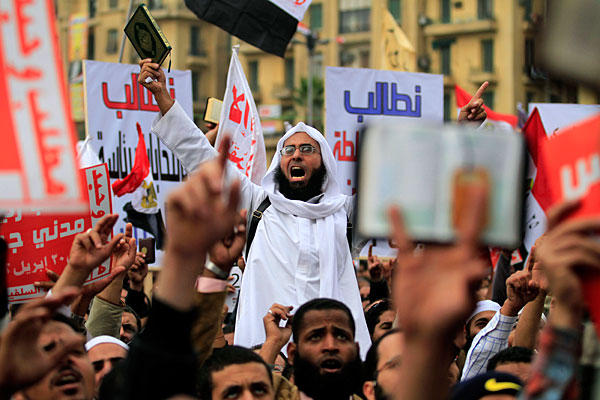
Pressure on Egypt’s military leadership to relinquish power escalated exponentially on November 18, as tens of thousands of protesters returned to Tahrir Square for the largest demonstration since July. Protesters, a majority of whom appeared to be affiliated with the Muslim Brotherhood, Salafis and other Islamist groups, are demanding that the government retract proposed supra-constitutional principles that have been broadly condemned as an at attempt by the military to dictate the drafting of Egypt’s next constitution and construct a legal firewall around its political and economic privileges, including provisions to shield the military’s vast budget – estimated to be around US $4.5 billion – from parliamentary oversight.
In an effort to prevent the military from hotwiring the constitution with provisions that could prolong and further institutionalize a system of military rule, an array of liberal and Islamist political forces called for a massive demonstration in Tahrir Square on November 18, and the Brotherhood went so far as to threaten a “second revolution” on January 25 if the draft document is ratified. As the crowd in Tahrir Square swelled over the course of the day, the military initially took a hands-off approach, surveying the scene with helicopters rather than unleashing its usual bag of tricks: tear gas, riot shields and rubber bullets. However, after protesters refused to vacate the square and continued to rally for a second day straight, security forces resorted to violence, sparking fierce clashes that had resulted in at least 676 injuries by November 20.
Friday’s demonstration and the ensuing violence has backed the SCAF into a corner and exposed its glaring illegitimacy. By the end of the day on November 18, there were reports – later denied – that Prime Minister Essam Sharaf had agreed to defer issuing the constitutional principles until after parliamentary elections and the SCAF announced that the guidelines would no longer be binding, but merely advisory. Although it now appears that the Cabinet will resume discussion of the draft document as early as this week, promising to engage political forces in an inclusive dialogue on the substance of the text, the interim government has clearly been put on the defensive by the latest mass demonstration and will face an uphill battle in reaching any sort of consensus on a document that has been so thoroughly repudiated as a recipe for military dictatorship.
Aside from further discrediting the constitutional principles, the demonstration had a secondary and equally significant result: reconciliation among rival Islamist forces that have becoming increasingly divided in recent weeks by fierce competition on the campaign trail. In a surprising turn of events, the Tahrir protest appeared to signal renewed unity among these diverse Islamist forces, which failed to coalesce into a unified electoral alliance at the start of the campaign season, when heated negotiations over the allocation of parliamentary seats led to a major fallout between the Brotherhood’s Freedom and Justice Party (FJP) and the next most organized Islamist force, the Salafi al-Nour Party.
Over the summer, the FJP had succeeded in co-opting a number of other Islamist groups into the Democratic Alliance, but when it came time to draw up a joint list of candidates in October, it became clear that the FJP would claim the lion’s share of seats for its own candidates, occupying 90 percent of the alliance’s slots for individual candidacy races and 70 percent of the part-list slots. Accusing the FJP of dominating the joint lists and marginalizing other alliance members, al-Nour and other Islamist parties swiftly defected from the Alliance and tried to regroup in a new Islamist coalition. Led by al-Nour, the Salafi Asala Party, and al-Gama’a al-Islamiyya’s Building and Development Party, the nascent Islamic Alliance tried unsuccessfully to rope in a variety of other Islamist forces – the Salafi Fadila and Amal parties, al-Tawheed al-Arabi, the centrist Wasat Party and a Brotherhood splinter party, al-Riyada – but negotiations broke down before the deadline for registering parliamentary candidates.
Over the course of the campaign period, Islamist parties have been acting more like rivals than allies. In late October, Essam al-Arian, vice president of the FJP, bluntly ruled out cooperation with Salafi parties, dismissing them as inexperienced. “It is better and wise … to work individually. [The Salafis] are newcomers to political life and they will be a burden for any coalition,” he said. Although Islamists parties collectively could claim up to thirty percent of the People’s Assembly seats, by some estimates, their failure to cooperate is likely to split the Islamist vote, weakening their overall parliamentary representation relative to liberal and leftist parties.
Until now, dueling Islamist parties have been too preoccupied with their own differences to mobilize against the ruling Supreme Council of the Armed Forces (SCAF) as a unified front, but the proposed supra-constitutional principles designed to legally codify the military’s political and economic privileges seem to have reminded the Islamists that they share a common opponent. The major Islamist parties, which expect to be well-represented in the next People’s Assembly, have universally rejected the draft principles, which would encroach on the parliament’s authority to select a 100-member assembly responsible for drafting the next constitution and would therefore undermine the ability of Islamists to enshrine religious values in the new legal framework.
United by their shared frustration with the military leadership, Islamist protesters in Tahrir Square on November 18 displayed unity and solidarity for the first time in months. Ironically, in an attempt to consolidate its power with the draft principles, the SCAF has actually weakened its position by galvanizing its Islamist opponents around the common goal of ending military rule. Rallying side by side in the packed square and chanting anti-military slogans in unison, Brotherhood members and Salafis appeared to put their ideological differences aside, at least for the time being. The Salafi preacher Hafez Salama gave a speech from a stage set up by the Muslim Brotherhood in which he called for unity among the Islamist parties and urged them to back a single candidate in each district, to avoid splitting the Islamist vote. The al-Nour Party, which only a few weeks ago was trading accusations of campaign fraud with the Freedom and Justice Party, distributed flyers urging all Islamists to unite behind a shared vision for an Islamic Egypt and calling for a conference at a major mosque to promote cooperation between Islamist groups.
With election day fast approaching, will this new display of unity inspire last-minute coordination between Islamist candidates? Whether or not Egypt’s powerful but diverse Islamist forces can find common ground could have significant implications for their representation in the next parliament.
Mara Revkin is the assistant director of the Rafik Hariri Center for the Middle East and editor of EgyptSource. She can be reached at mrevkin@acus.org.
Photo Credit: Christian Science Monitor.
Image: 1118-egypt-Tahrir-square_full_600-1.jpg

